TRANSPORTS CITROEN - RESEAU DE LYON
Transports Citroën
Réseau de Lyon
43 rue du Lt Col Girard
69007 LYON
RC Lyon B9019
Réseau de Lyon
43 rue du Lt Col Girard
69007 LYON
RC Lyon B9019
1932 -1933
The Lyon network appears to have really got into its stride in the year of 1933, even if 1932 is the official year of creation.
The Auvergne office advised the authorities that they intended to start a route from Clermont-Ferrand to Lyon on 29 March 1933, beginning with two daily returns. The vehicle would have seats for 20 passengers, with the possibility of two additional tip-up seats. Citroën requested a Lyon terminus at Pont Lafayette. This was route n° 17 - the archives carry a file for each route and there is an original timetable in many of them.
As usual at this time, OTL was ferociously opposed to operators wanting to establish their terminus in Lyon. On 15 April 1933, OTL pointed out that this route duplicated their Lyon – Trois Renards – Meridien service, and requested that there be non-stopping arrangements within the town. OTL used the same procedure for most Citroën routes.
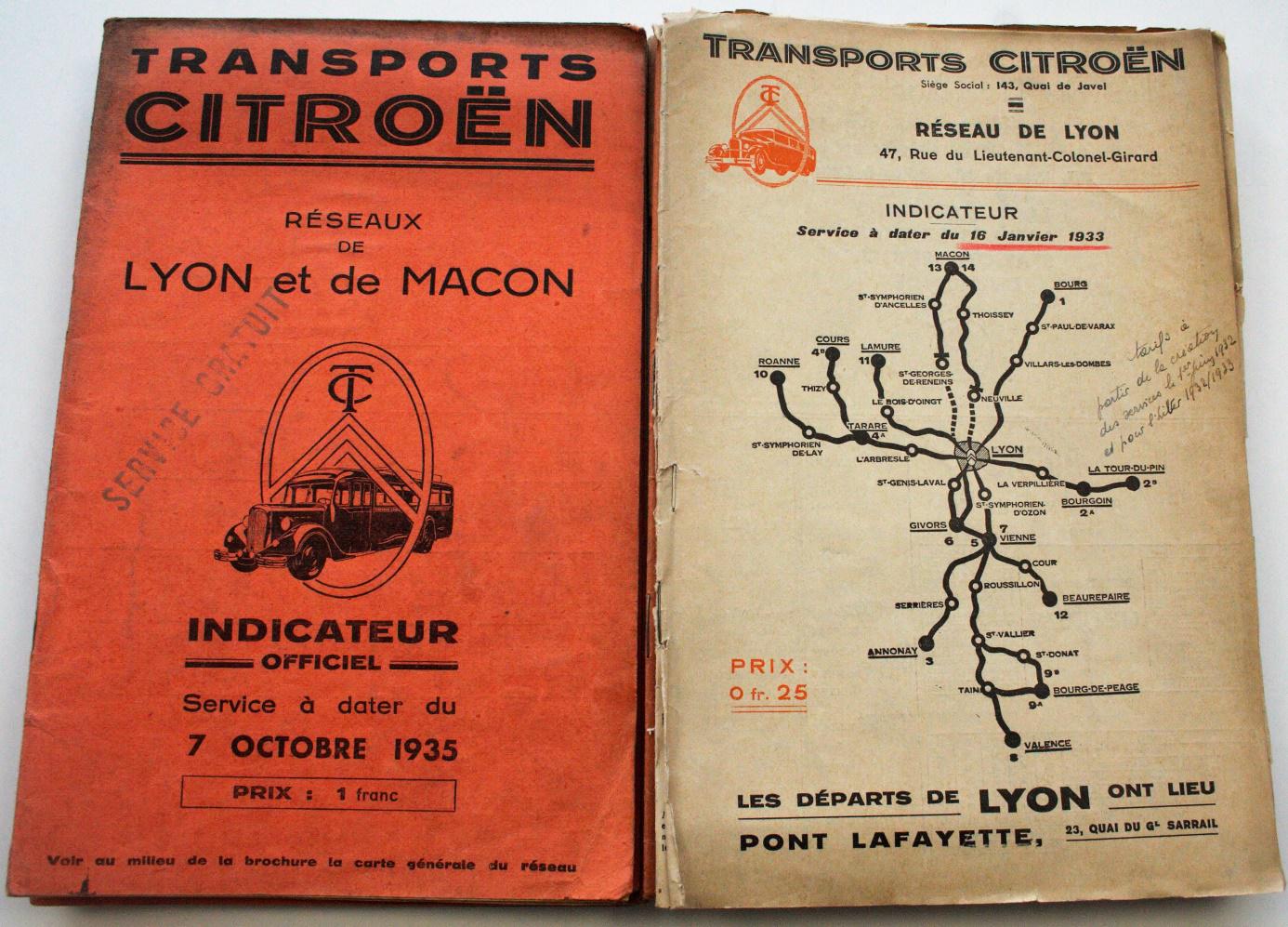
Lyon
area booklets for 1933 (right) and 1935 (left)
1934
Maybe traffic congestion existed already! The Lyon municipality and the Ponts & Chaussées had their plan for revising the traffic flows and termini in Lyon.
The result was a letter of 17th April 1934 imposing the grouping of the termini of 16 Citroën services at 28, cours de Verdun. They are listed as follows (the significance of the series number is unclear to the writer, and the route numbers do not always correspond to the Citroën system):
Serie EJ – route 18A Lyon to
Bourgoin and La Tour du Pin
Serie IJ – route 9 Lyon to Bourg-de-Péage and Valence
Serie IJ – route 14 Lyon to Vienne
Serie IJ - route 16 Lyon to Annonay
Serie IJ – route 13A Lyon to Givors via Pierre Bénite
Serie MP – route 4 Lyon to Roanne
Serie MP – route 5A Lyon to Tarare
Serie MP – route 5B Lyon to Cours
Serie MP – route 84 Lyon to Montbrison
Serie MP – route 85 Lyon to Clermont-Ferrand
Serie MP – route 113 Lyon to Vichy via Tarare
Serie MQ – route 22 Lyon to Lamure sur Azergues
Serie MQ – route 25 Lyon to Mâcon & Chalon via Villefranche
Serie MQ – route 114 Lyon to Charolles
Serie MQ – route 134 Lyon to Le Creusot
Serie MS – route 24 Lyon to Mâcon via Trévoux
Four other routes (all serie A) retained their terminus at avenue Verguin between rue Masséna and the Pont PLM. They were:
Route 18B Lyon to Bourg
Route 111 Lyon to Lons-le-Saunier
Route 120 Lyon to Geneva
Route 128 Lyon – Ambérieu – Jujurieux Bourg
Serie IJ – route 9 Lyon to Bourg-de-Péage and Valence
Serie IJ – route 14 Lyon to Vienne
Serie IJ - route 16 Lyon to Annonay
Serie IJ – route 13A Lyon to Givors via Pierre Bénite
Serie MP – route 4 Lyon to Roanne
Serie MP – route 5A Lyon to Tarare
Serie MP – route 5B Lyon to Cours
Serie MP – route 84 Lyon to Montbrison
Serie MP – route 85 Lyon to Clermont-Ferrand
Serie MP – route 113 Lyon to Vichy via Tarare
Serie MQ – route 22 Lyon to Lamure sur Azergues
Serie MQ – route 25 Lyon to Mâcon & Chalon via Villefranche
Serie MQ – route 114 Lyon to Charolles
Serie MQ – route 134 Lyon to Le Creusot
Serie MS – route 24 Lyon to Mâcon via Trévoux
Four other routes (all serie A) retained their terminus at avenue Verguin between rue Masséna and the Pont PLM. They were:
Route 18B Lyon to Bourg
Route 111 Lyon to Lons-le-Saunier
Route 120 Lyon to Geneva
Route 128 Lyon – Ambérieu – Jujurieux Bourg
As stated above, there is a difference between some route numbers and those on the timetable leaflets where for example route 85 is 17 and route 84 is 15. Again the reason is unexplained.
1937
A PLM document dated 2nd February stated that passenger trains were going to cease running on Chalon – Bourg and Sathonay – Trévoux. This decision was taken in order to comply with Ministerial Circulars of 12 August and 23 November 1936 implementing the coordination of rail and road services.
Transports Citroën were expected to introduce replacement bus services. But in return for being given these routes, and more of the same kind in other regions, Citroën were expected to cease operating elsewhere, namely:
Lyon to Bourg
Lyon to Lons le Saunier
Paris to Dijon
Dijon to Lons le Saunier
Lyon to Montbrison
Paris to Auxerre
Chalon to Dôle
Lyon to Lons le Saunier
Paris to Dijon
Dijon to Lons le Saunier
Lyon to Montbrison
Paris to Auxerre
Chalon to Dôle
A month earlier, Transports Citroën (in a letter dated 20/01/1937) had already put its name forward as willing to operate services on:
Chalon - Bourg
Chalon – Lons le Saunier
Chalon - Cluny (partially)
Sathonay – Trévoux (including services currently operated by STMJ)
Givors – Peyraud
Avallon – Semur
Semur – Les Laumes
Avallon – Ravières
Nuit-sous- Ravières – Châtillon sur Seine
Chalon – Lons le Saunier
Chalon - Cluny (partially)
Sathonay – Trévoux (including services currently operated by STMJ)
Givors – Peyraud
Avallon – Semur
Semur – Les Laumes
Avallon – Ravières
Nuit-sous- Ravières – Châtillon sur Seine
But they had certainly not yet agreed to give up all the routes listed by PLM ; Citroën had other concerns. For instance, they considered the tariffs for carrying baggage and packets far too low, but were willing nevertheless to accept them in order not to imperil the project.
There is no clear evidence as to whether any of these plans came to fruition.
Locally, in 1937, the company said that they were no longer willing to serve the village of Grandris, on the Charolles route (114). Fare income from the stop was said to be an average of only 2 F per week, and the narrow roads through the village had caused excessive damage to bodywork.
1939
Only later on 4 December 1939 does a convention appear to have been signed between Citroën and the départements 69 and 71 to operate Chalon – Macon – Lyon and Lyon - Vienne.
Chalon – Mâcon – Lyon (départements Saône-et-Loire and Rhône)
Calculation of costs.
Fuel :
0.33 per km for a 22 seater
0.40 per km for a 30 seater
Tyres:
0.15 per km for a 22 seater
0.20 per km for a 30 seater
Repairs and maintenance:
0.40 per km for a 22 seater
0.50 per km for a 30 seater
Depreciation:
0.48 per km for a 22 seater (based on a type 32)
0.56 per km for a 30 seater (based on a type 45)
Frais Généraux (ie all other costs not covered above):
0.68 per km for a 22 seater
0.82 per km for a 30 seater
0.33 per km for a 22 seater
0.40 per km for a 30 seater
Tyres:
0.15 per km for a 22 seater
0.20 per km for a 30 seater
Repairs and maintenance:
0.40 per km for a 22 seater
0.50 per km for a 30 seater
Depreciation:
0.48 per km for a 22 seater (based on a type 32)
0.56 per km for a 30 seater (based on a type 45)
Frais Généraux (ie all other costs not covered above):
0.68 per km for a 22 seater
0.82 per km for a 30 seater
Other elements taken into account:
Driver’s salary (two years’
experience in Lyon) 500 FRF per week
Vehicle Depreciation – type 32 - 104,000 F; type 45 - 140,000 F
An accountant – two years’ experience and based at Dijon – 1,625 F.
Vehicle Depreciation – type 32 - 104,000 F; type 45 - 140,000 F
An accountant – two years’ experience and based at Dijon – 1,625 F.
Result – an operational cost of 3.18 F per km for a 22 seater, 3.75 F per km for a 30 seater.
The SNCF advertised a changeover on 6 March 1939.
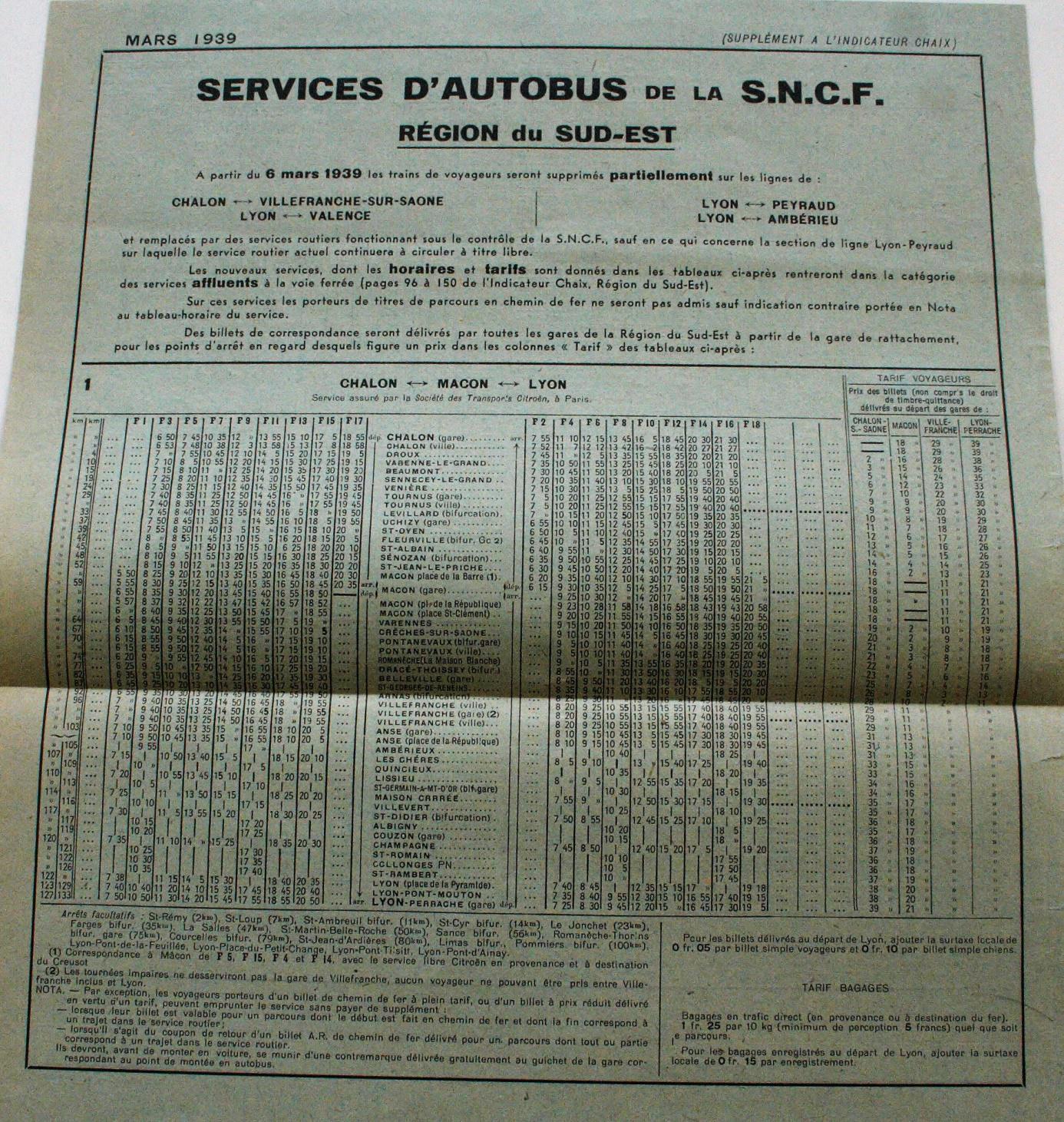
The SNCF made its announcement in March 1939, showing the timings of the NEW road-based services on Chalon – Villefranche, Lyon –Valence, Lyon – Peyraud and Lyon – Ambérieu, and Citroën timetables for routes 8, 9, 12 and 24 were modified.
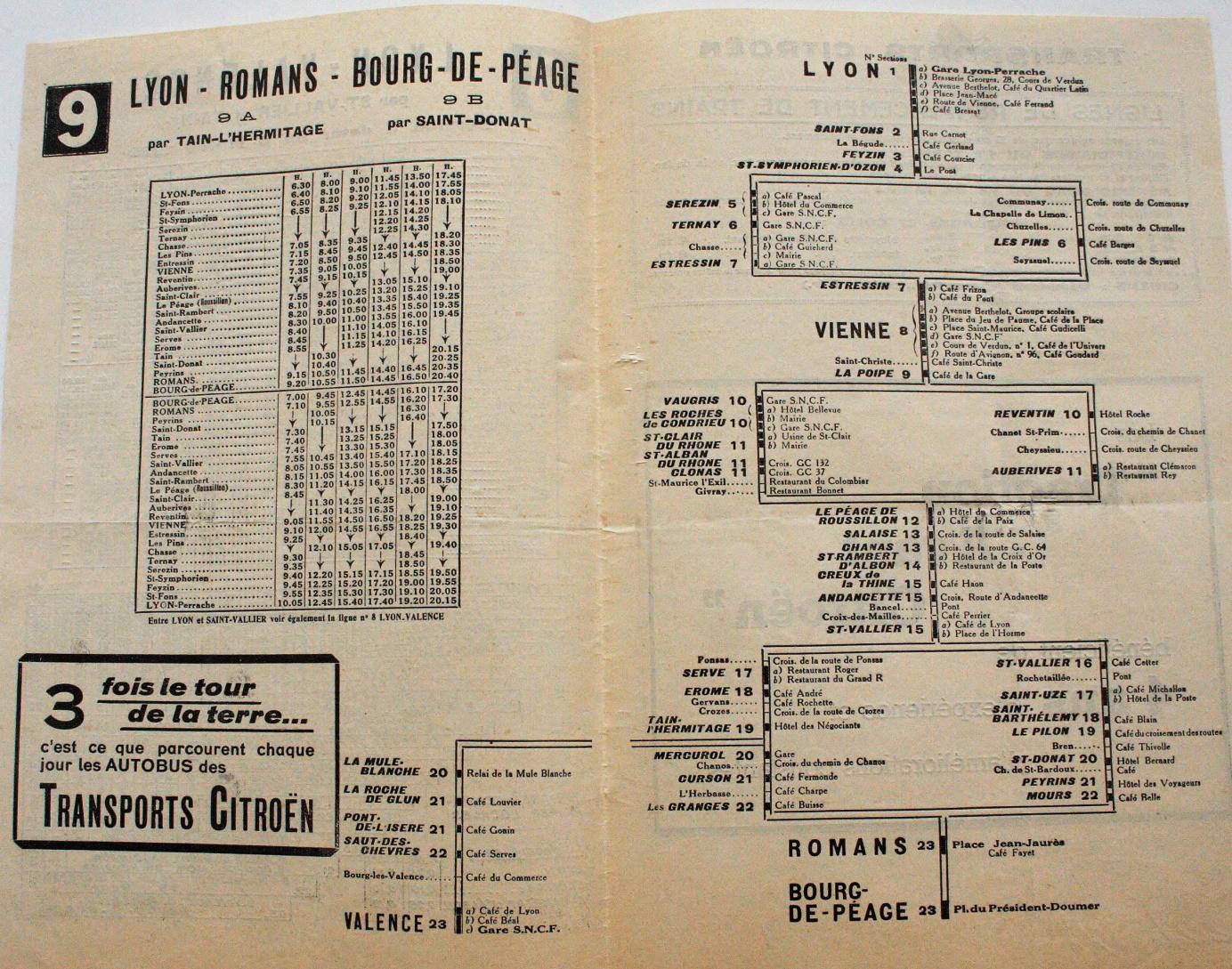
1939
- route 9 Lyon to Bourg-de-Péage
It would appear from a codicil to the convention that finally Citroën ceased to operate the following services:
Dijon – Louhans ( ceased on
01/07/1938 between Seurre and Louhans)
Moulins to Paray le Monial (section from Moulins to Mâcon)
Lyon - Charolles
Lyon - La Tour du Pin
Lyon - Tarare
Lyon - Vichy
Lyon - Lamure Charolles
Lyon - Geneva
Moulins to Paray le Monial (section from Moulins to Mâcon)
Lyon - Charolles
Lyon - La Tour du Pin
Lyon - Tarare
Lyon - Vichy
Lyon - Lamure Charolles
Lyon - Geneva
Transports Citroën considered it never received the promised alternative business of equal proportions.
1940
On 30 August, the company received a specific authorisation for one Citroën vehicle 9316PG (capacilty 29 + 11) to park at 28 cours de Verdun, Lyon, for passengers to alight. Unlimited layover time was allowed in rue Smith and rue Delandine, and fixed stops were at 28, cours Verdun, avenue Berthelot, corner of quai Bernard, corner of rue des Culattes, corner of route de Vienne, corner of chemin du Moulin à Vent.
1942
We are now in the difficult years of the war.
On 24 November, the « Comité restreint départemental de transports de voyageurs » produced its « Plan Minimum Réduit », cutting services in view of the scarcity of resources. Citroën services were affected :
Lyon - Châlon via RN6 – service
discontinued. The Rhône section was covered by Lyon Mâcon, even if the
route taken was different.
Lyon - Mâcon via RN433 – no change
Lyon - St Rambert - Valence - Romans – no change
Lyon- Vienne – 6 daily returns
Mâcon - Bourg – did not concern the Rhône
Lyon - Cours – apparently will be run by Paget
Lyon - La Tour de Salvagny - OTL was willing to transfer this service to Citroën permanently even after the end of the war. Committee to propose this to Citroën.
Lyon - Mâcon via RN433 – no change
Lyon - St Rambert - Valence - Romans – no change
Lyon- Vienne – 6 daily returns
Mâcon - Bourg – did not concern the Rhône
Lyon - Cours – apparently will be run by Paget
Lyon - La Tour de Salvagny - OTL was willing to transfer this service to Citroën permanently even after the end of the war. Committee to propose this to Citroën.
Here are further examples of wartime cost savings:
Lyon – Valence: had an
authorization as at 02/03/1939 for 9 daily returns
Lyon – Romans via St. Donat had 3 daily returns
Lyon – Romans via Tain had 2 daily returns
Lyon – Romans via St. Donat had 3 daily returns
Lyon – Romans via Tain had 2 daily returns
All were reduced in 1942 to a single daily return from St. Rambert to Valence, extended once a fortnight to Lyon, and a single daily return from St. Rambert to Romans.
This was only slightly relaxed from 22/05/1945, with:
Lyon – Valence 1 daily return
Lyon – Romans via St. Donat 1 daily return
Lyon – Romans via St. Donat 1 daily return
1945 - 1946
On 11 September 1945, Citroën requested
The suppression of their war-time
rail replacement services on St. Vallier - Valence and St. Vallier -
Romans
Authorisation for 1 daily return Romans – Lyon via St. Vallier
Authorisation for a Mâcon – Chalon service
Authorisation for 1 daily return Romans – Lyon via St. Vallier
Authorisation for a Mâcon – Chalon service
An undated handwritten note, probably from 1946, gives a snapshot of route frequencies:
(all routes from Lyon: AR = aller retour)
Cours
3 AR
Tarare 3 AR
Châlon 6 AR
Clermont-Ferrand 2 AR
Romans 6 AR (2 of these via St. Donat)
St. Etienne 54 AR (78 on Sundays and Bank holidays)
Roanne 6 AR
Le Creusot -
Trévoux Mâcon 8 AR
Vienne 28 AR
Valence 6 AR
Annonay 8 AR
La Tour du Pin 4 AR
Jassans 5 AR
3 AR
Tarare 3 AR
Châlon 6 AR
Clermont-Ferrand 2 AR
Romans 6 AR (2 of these via St. Donat)
St. Etienne 54 AR (78 on Sundays and Bank holidays)
Roanne 6 AR
Le Creusot -
Trévoux Mâcon 8 AR
Vienne 28 AR
Valence 6 AR
Annonay 8 AR
La Tour du Pin 4 AR
Jassans 5 AR
As soon as possible, Citroên wanted to develop the service to Valence and Romans. A request to increase services from 1 to 3 daily returns was submitted in 1947. This took account of the fact that under full peacetime conditions 6 returns were foreseen. Apart from Balaye, other competitors on this corridor at the time were Alloncle in Romans, with a St. Donat to St. Symphorien d’Ozon via Péage de Roussillon service, and Gauthier at Cour de Buis, who ran from Beaurepaire to Lyon via Vienne.
1948
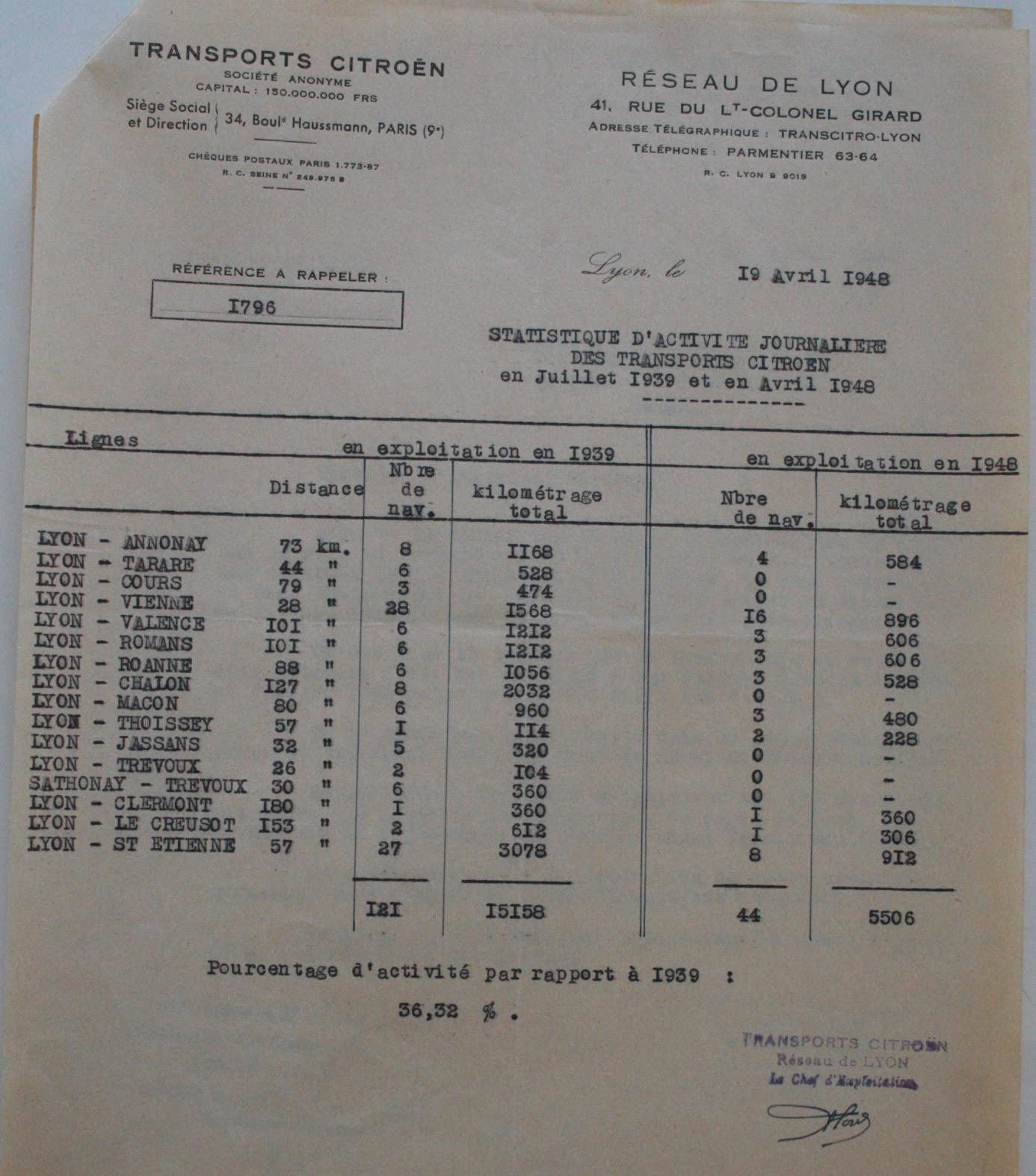
These
statistics above were produced in 1948.
Whereas in 1939 the company ran 15,158 kms , in 1948 this had dropped to 5,506, only 36.32%.
There was a constant battle with the authorities to reinstate pre-war frequencies (see under 1952).
1949
A decree dated 14 November made obligatory a Plan Départemental de Transports Voyageurs, completed by Circular n° 78 of 12 July 1952.
1952
On 29 April 1952, the ‘Passenger’ sub-committee of the CTD (Comité technique Départemental) des Transports de l’Isère had on its desk a request from Citroën to return to peace-time frequencies. Citroën considered that the ‘compensations’ promised (see 1939) had never materialized, and that also, on 01/01/1950, the SNCF had withdrawn the financial guarantees previously given for rail replacement routes.
This meant, firstly, restitution of former pre-war routes:
Lyon – Bourg. Stopped on
14/05/1939. Previously 9 daily returns. In 1952, Philibert was the
incumbent with 2 returns, as a result of which
Citroën had been refused access in 1951.
Lyon – La Tour du Pin. Stopped in 1939, when 4 journeys operated. In 1952, request for 9 daily returns.
Lyon to Tarare, to Cours and to Montbrison. Stopped in 1939, since when STUR Paris had been running 2 journeys. Citroën requested three,
in spite of the fact that the Ministry of Transport, on advice from the Conseil Supérieur des Transports, had formally vetoed Citroën’s return
to these routes. But see 1961, when the routes were running……
Lyon – Vichy. Stopped before July 1938. Request for two daily returns, as before.
Lyon – Genève. Stopped in May 1939, when the frequency was 2 daily in summer, one in winter. A new licence was refused by the Ministry
of Transport on 26/01/1949 and on 31/01/1951 but Citroën was insisting.
Citroën had been refused access in 1951.
Lyon – La Tour du Pin. Stopped in 1939, when 4 journeys operated. In 1952, request for 9 daily returns.
Lyon to Tarare, to Cours and to Montbrison. Stopped in 1939, since when STUR Paris had been running 2 journeys. Citroën requested three,
in spite of the fact that the Ministry of Transport, on advice from the Conseil Supérieur des Transports, had formally vetoed Citroën’s return
to these routes. But see 1961, when the routes were running……
Lyon – Vichy. Stopped before July 1938. Request for two daily returns, as before.
Lyon – Genève. Stopped in May 1939, when the frequency was 2 daily in summer, one in winter. A new licence was refused by the Ministry
of Transport on 26/01/1949 and on 31/01/1951 but Citroën was insisting.
The request also included:
Lyon to La Tour du Pin – 4 daily
returns (discrepancy with above)
Lyon to Vienne – 28 daily returns instead of 24
Lyon to Valence – 6 daily returns instead of 3
Lyon to Chalon – 8 daily returns
Lyon to Vienne – 28 daily returns instead of 24
Lyon to Valence – 6 daily returns instead of 3
Lyon to Chalon – 8 daily returns
It is difficult to paint a clear picture of what Citroën obtained.
The Isère noted that in their Plan Départemental, all these routes were in fact co-ordinated under the responsibility of the CTD Rhône, and not the Isère. Apparently the Rhône would be discussing this request in their meeting on 5 June 1952. After a number of points detrimental to Citroën had been discussed a vote was taken – one vote in favour of Citroën, 6 against.
The CTD Drôme, on 8 July 1954 also had to examine a (repeated) request for an increase from 3 to 6 in services on Lyon Valence. CTD Drôme awaited the response from the Isère on 27 July 1954, discovered the Isère had confirmed its 1952 refusal a second time, and so said no as well.
What did the CTD Rhône have to say? Well on 8 March 1956 it was still drawing up the ‘new’ Plan de Transports des Voyageurs, including the proposals from Citroën for the Valence and La Tour du Pin routes.
For Lyon - Valence, responsibility for co-ordinating the route had now been handed back to the CTD Drôme (!)
The Rhône Plan called for 6 daily returns, but Citroën was still only authorized to run three. Apparently a major stumbling block had been the inability of Citroën and SNCF to agree on coordinated tariffs (the SNCF running up to 8 daily passenger trains on the Lyon Valence corridor). Since, as at 8 March 1956, the CTD Drôme had still not finalized its projected Plan, the CTD Rhône now unanimously agreed to the increase to 6 daily returns and would inform the CTD Drôme. Four years to get an agreement!
As for Lyon - La Tour du Pin, neither Plan (Isère or Rhône) wanted to reintroduce the Citroën route
In 1934, there had been 5 returns Lyon- La Tour du Pin plus 4 partials Lyon - Bourgoin.
In 1937 this reduced to 4 returns Lyon - LTDP
In October 1938 the Wednesday service was withdrawn.
On 26 August 1939, the service was stopped, the vehicles having been requisitioned by the authorities.
The CTD Isère was now the centralizing authority for this route.
In 1956, the SNCF had 15 daily services covering Lyon LTDP. And competition on the road was intense.
RICOU of Grenoble had up to 13 timings from Grenoble to Lyon via either Bourgoin or La Tour du Pin.
He objected as he had been running this service uninterrupted since 1945.
PHILIBERT of Lyon ran up to 4 services on Lyon – LTDP – Annecy, but he was in agreement to Citroën’s request.
PACCARD of Novalaise ran a single Novalaise – LTDP – Lyon service. He too agreed to Citroën’s request.
DUBOIS at Pont-de-Beauvoisin ran 2 daily services Pont de Beauvoisin – LTDP – Lyon. He opposed the request.
BOURDAT at St. Marcellin ran a single timing to Lyon via Bourgoin. He opposed the request.
ALLOIN at Dolomieu ran a single timing to Lyon via Bourgoin. He opposed the request.
A vote was taken, and the CTD Rhône agreed to the position of the Isère – that there was no need to reintroduce a service where sufficient alternatives already existed.
1953
In December the authorities required further information on who was really operating the Lyon to St. Etienne service. On 16/03/1946 the Ministry of Transport had authorized joint operation in the interests of avoiding unnecessary competition. An ‘association de fait’ between Citroën and Sté Automobile du Centre (Gatti & Cie) shared the work 50/50.
In 1953, each operated:
Mon to Sat Sun & Bank Holidays TOTALS
Summer 27 AR 39 AR 54 & 78
Winter 24 AR 33 AR 48 & 66
Also in 1953, frequencies on Lyon – Roanne were increased to 6 daily.
1960
Citroën wanted to review its timetables on three routes with effect from 12 July as a result of the acquisition of vehicles with a more powerful engine, giving a thirty minute gain on Valence journey time, 15 minutes on Annonay, variable on Bourg-de-Péage. The CTD agreed.
1961
On 29/05/1961, the SNCF agreed to one timing it was abandoning being replaced by a bus.
So Citroën put in place a Lyon – Tarare timing:
11.00 LYON > Tarare 12.20
15.00 LYON < Tarare 13.45
15.00 LYON < Tarare 13.45
1972
The company buses were involved in a fares scandal, as typified by an inspection of Berliet 4058QF63, on the Clermont Ferrand to Lyon route! The Rhône tariffs, fixed on 01/03/71, were no longer respected, and a company surcharge on 10% was illegally applied - eg Feurs to Lyon 9F instead of 8F30.
There was a fatal accident on 18 December, involving vehicle 1305DE69, year 1968, chassis 8546364, make not indicated, at 12.30 on the RN 7 between Auberives and Péage de Roussillon. A Peugeot 403, coming in the opposite direction, was on the wrong side of the road and had no lights on in spite of the fog. Both occupants of the car were killed outright.
1972 - 1973
The 1970s are a long litany of falling passenger numbers.
In January 1972 and again in 1973, the group of routes –
Ligne 8 Lyon to
Valence
Ligne 9 Lyon to Bourg de Péage
Ligne 18 St. Etienne to Valence
were ‘reorganised’. The usual reasons of better productivity and
improved connections were put forward.Ligne 9 Lyon to Bourg de Péage
Ligne 18 St. Etienne to Valence
And on 13 July 1973 Ligne 18 was abandoned, although the technique in these cases is to suspend the route, giving the false impression that it might be reactivated at a later date.
The 18’s deficit in 1972 had been 66,866.03 FRF and it was estimated that it would reach 78,000 FRF in 1973 if nothing were done. The first quarter loss in 1973 was 19,178.82 FRF, hardly surprising when you see the revenue per kilometer in centimes –
1972 1973
January 0.64 0.53
February 0.60 0.60
March 0.62 0.60
In fact the route had just two departures from St. Etienne at 07.00 and 14.45, with returns at 09.00 and 18.20 – a journey time of 1 hr 15.
On the 23 km section from St Etienne to Rive de Gier there was competition from Cars Rouge.
On the 12 km section from Givors to Vienne there was competition from Les Cars Lyonnais
On the middle 13 kms between Rive de Gier and Givors there was no competition, but no villages and so no passengers!
In March 1973 it was the turn of route 25 Lyon to St. Etienne, operated jointly with Cars Gatty, under an arrangement detailed above under the year 1953.
The fall in numbers here was 4.4% in 1970/1971, 6% in 1971/1972, the equivalent to a 10.8% fall over the two years 1970 to 1972.
As a consequence there were significant cuts on Sundays and in July and August. Weekday timings were reduced from 36 to 30, still a considerable number by today’s standards.
1974
Changes to timetables had now become too numerous to examine individually.
This also saw what was, maybe, Citroën’s swan song.
In 1972, the catchment area of Lyon was extended to include Feyzin, and TCRL extended route 48 to a new terminus. Very normal now, but something of a novelty 47 years ago. This had an effect on Citroën, who had a contract to transport refinery workers, and whose routes 3, 7, 8, and 9 carried 41 passengers per day on that section. Citroën received help from the GIE Commutrans, RC71C30 20 rue Cronstadt, 69007 Lyon, president A Balaye, an organisation set up to mutualise help to its members, and the préfêt was taken to court on the basis that he had exceeded his powers in authorizing the extension on 01/06/1972. But before the case could be heard, Citroën withdrew on 13/06/1974.
1975
On route 3 Lyon to Annonay, it was confirmed that from 5 May, service Serrières (06.02) to Lyon (07.20) would no longer operate on Sundays, Bank holidays or from 14 July to 31 August. This timing had been introduced when the SNCF abandoned passenger trains on a line from Givors to Nîmes.
Now average income per journey was 7.90 FRF, or 0.88 centimes per km. Although the route was only 59 kms long, the cost included positioning a vehicle which had to travel from Vienne (31 kms).
The maximum load had been 5 passengers on 26 August 1973, who paid 31.60 FRF, whilst frequently the vehicle ran empty.
Service reductions to be applied as from 15/09/1975 concerned several routes, where the cuts were also justified by the calculation of fare income on the journeys concerned.
Route 6 Lyon – Givors – Sunday services to be axed:
10.00 > 10.45 Income per passenger km 1.61 F
17.00 > 17.45 0.79 F
12.00 < 11.15 2.44 F
19.00 < 18.15 1.53 F
Somewhat contradictory information elsewhere stated that services to be lost were returns leaving Lyon at 07.00 and 13.30, with the 10.00 and 17.00 retained.
Route 17 Lyon – Clermont-Ferrand – Sunday services to be axed:
06.30 > 11.00 1.29 F
14.40 > 19.10 1.43 F
11.45 < 07.15 1.21 F
19.00 < 14.30 2.61 F
In November 1975, after reclamations from municipalities, it would appear that the route 17 reductions were refused by the authorities, and that the company had reinstated them at least by 7/03/1976. How long that situation lasted is not clear.
Route 10 Lyon – Roanne – everyday services to be axed:
06.45 > 09.20 0.85 F
10.00 > 12.35 1.73 F
09.15 < 06.30 1.34 F
18.35 < 16.00 1.88 F
Although not strictly concerning Lyon, figures for Clermont-Ferrand also appear on file, since the two networks (Clermont-Ferrand and Lyon) were by now managed from Clermont.
The level of income on two Clermont services was:
Route 1 Clermont to St. Rémy
07/09/75 0.13 F per passenger km
14/09/75 0.39 F
21/09/75 0.61 F
28/09/75 1.18 F
05/10/75 1.08 F
12/10/75 0.39 F
26/10/75 0.50 F
Route 3 Clermont to Moulins where it was claimed that mid-morning services were not used.
10h10 service to Moulins - April 1975 – 1.05 F (excluding Saturdays)
May 1975 – 0.83 F (excluding Saturdays)
Sept 1975 – 0.92 F (excluding Saturdays)
14h15 service from Moulins – April 1975 – 0.89 (excluding Saturdays)
May 1975 – 1.03 F (excluding Saturdays)
Sept 1975 – 0.92 F (excluding Saturdays)
The intention therefore was to retain these timings only on Saturdays.
1976
More Sunday cancellations were authorized for a trial period of 3 months beginning 6 June 1976, with the result not recorded.
These affected :
3 Lyon to
Annonay
7 Lyon to Vienne (apparently as many as 9 timings cancelled)
8 Lyon to Valence
9 Lyon to Romans and Bourg de Péage (1 return cancelled)
7 Lyon to Vienne (apparently as many as 9 timings cancelled)
8 Lyon to Valence
9 Lyon to Romans and Bourg de Péage (1 return cancelled)
1977
In January, it was considered that the Centre Hospitalier Lucien Hussel near Vienne needed a service, which was provided by diverting a vehicle via Seyssuel. On weekdays at 14.30 this was a Lyon to Annonay bus, and at weekends it was a Lyon to Vienne bus, also at 14.30.
In March, Sunday services on Lyon – Vienne were reduced to an hourly frequency between 06.45 and 20.45 (except for 12.45).
On 23 May 1977, Mr Y. Verney wrote to the Préfêt de Lyon. He advised that with effect from 01/04/1977, all Transports Citroën’s passenger transport activities had been sold to the CFIT Compagnie Financière et Industrielle de Transports, Head Office, 3 rue Paul Beldant, LE MANS, General Management 28/34, blvd du Parc, 92521 NEUILLY SUR SEINE.
==++==++==++==++==++==++==++==++==++==++==++==++==++==
CFIT were associated with the Verney group whose story can be found here
==++==++==++==++==++==++==++==++==++==++==++==++==++==
Cutting across this chronological history, we have references to individual routes.
LYON - ANNONAY
As at 05/05/1939, the Coordination Committee allocated 8 winter and 12 summer returns. Subsequently, under the ‘Plan Minimum’ this was reduced to 6 returns daily (ordre de priorité 2).
On 31/07/1941, the SNCF warned that in October it would cease operating from Perrache to Peyraud, and asked for replacement buses from 06/10/1941. A proposed timetable with three timings was produced:
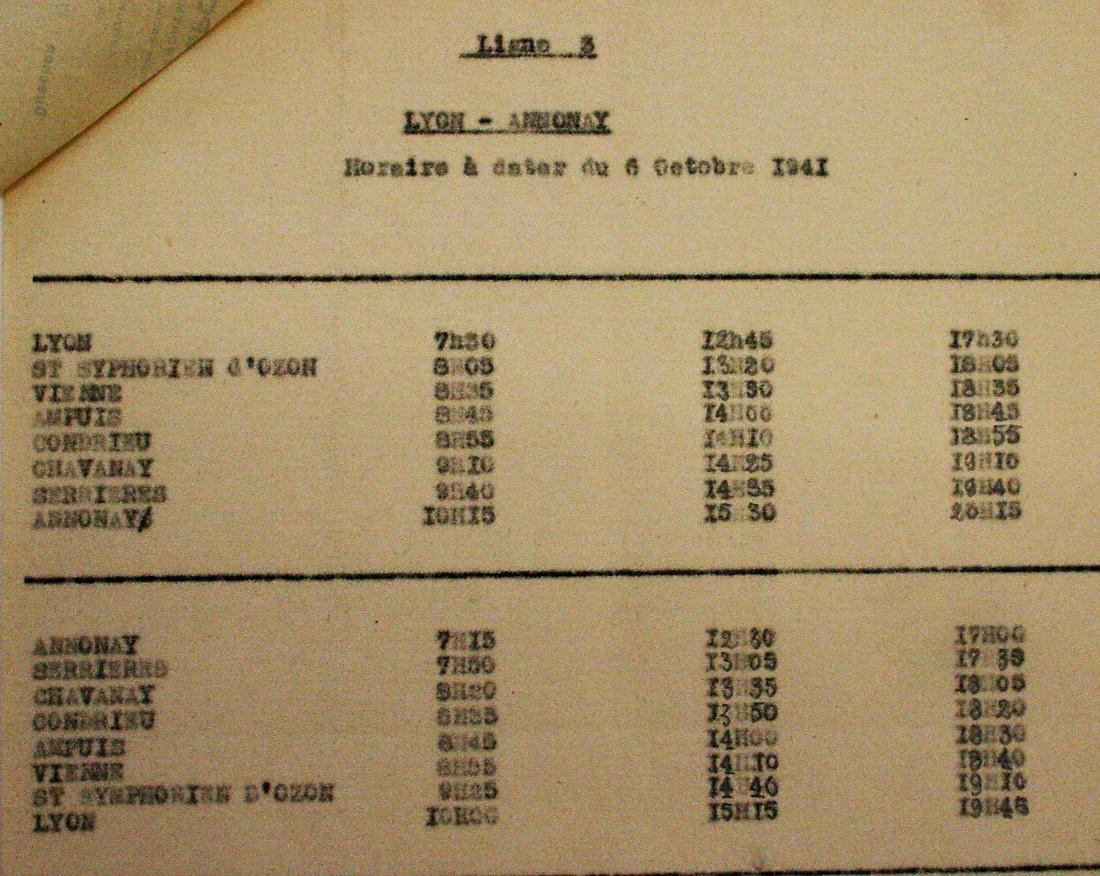
The Rhône agreed on 12/09/41 subject to agreement by Ardèche, who took until 26/09/41 to say yes.
The vehicles to be used (02/10/41) were:
9318 PG Permit n°118
9478 PG Permit n°113
1860 RF Permit n°107
1862 RF Permit n° 108
9336 PG Permit n° 32980
On 28/07/1943, still in wartime, users of the SNCF at Bourg Argental (15 kms from St. Etienne), and banded together as the Corporation Nationale Paysanne, were complaining of non-running and requesting extra buses. But there was a national wartime ban on that.
A similar request by Citroën on 22/02/1945 for 3 extra journeys was also refused on 05/03/1945.
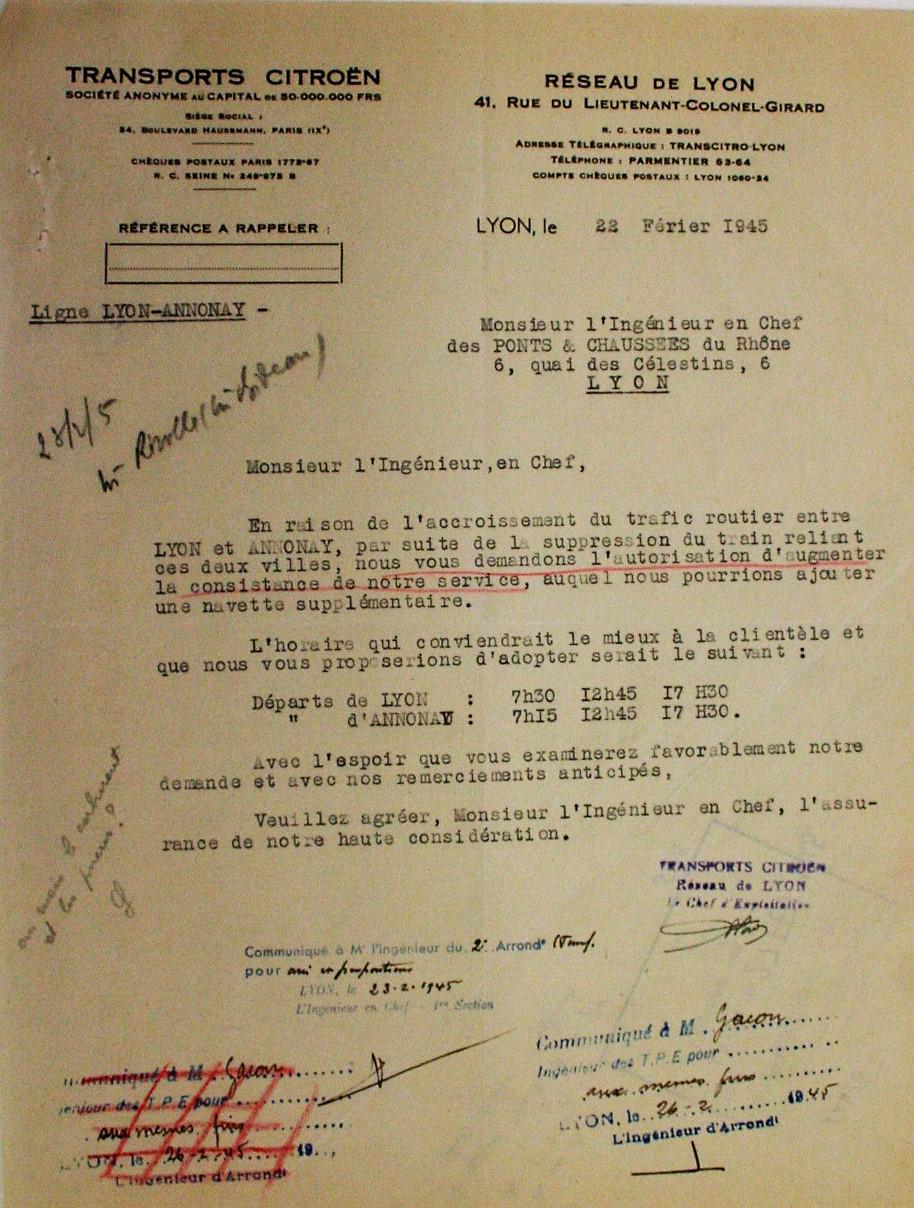
The
1945 request
On 08/03/1948, Citroën asked for 4 timings instead of 3. This was authorized on 20/05/1948.
Then on 27/04/1949, a further increase to 8 was agreed.
A request for more in 1953 was refused.
At last, the CTD agreed new frequencies on 08/03/1956 providing 9 timings.
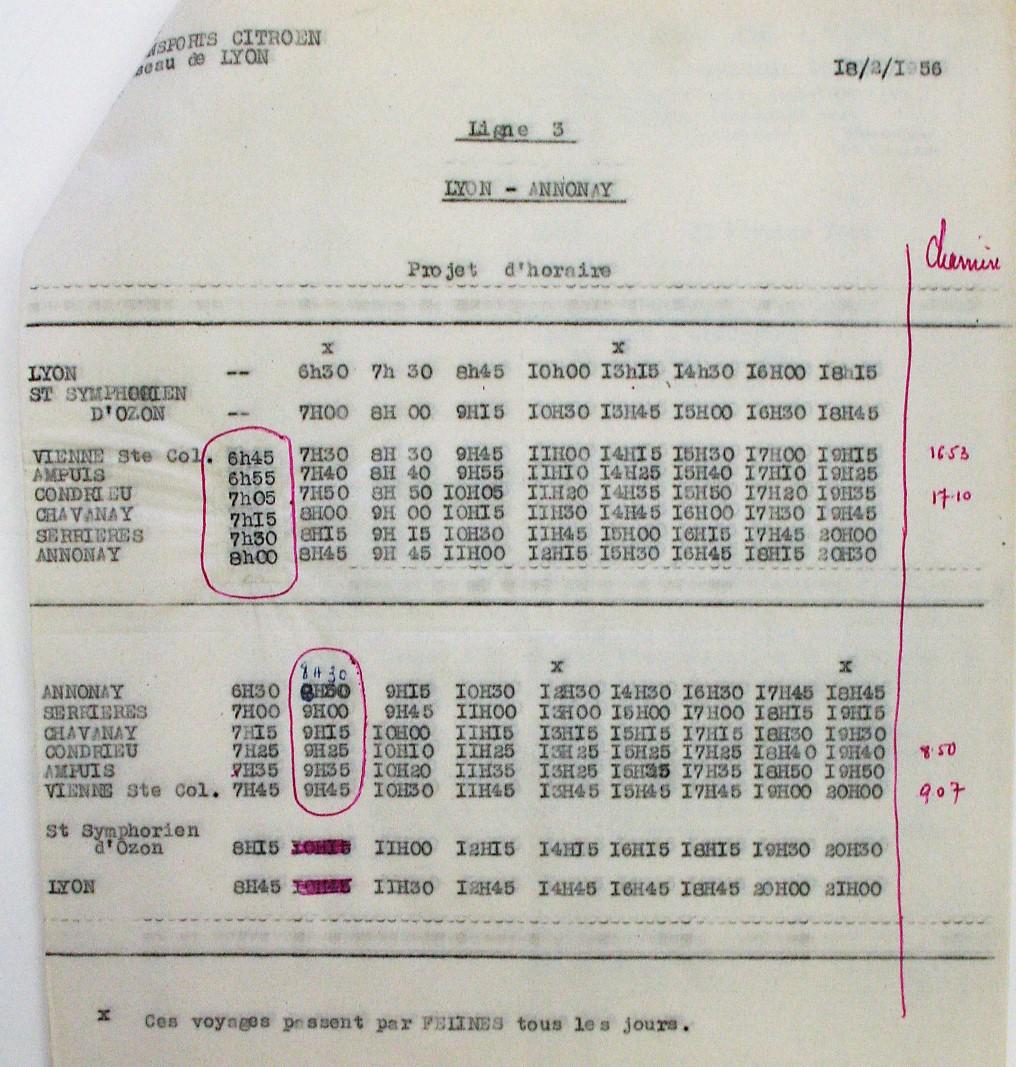
The
1956 proposed timetable.
LYON – VALENCE
Route frequency at the time of the 1934 Plan Transports was 6 returns in the winter, and 9 in the summer. In July 1939 this was reduced to 5, plus two short workings, one from Lyon to St. Rambert and one from St. Rambert to Valence.
This must have reduced further during the war, because 26/02/1951 saw an increase from 3 to 6. That increase was initially vetoed by the SNCF, but a compromise was worked out on 20/03/1951 when passenger trains were ended on Lyon – St. Rambert d’Albon and replaced by 12 shuttles –
7 from Lyon to St. Rambert via
Vienne (no local traffic between Lyon and St. Fons) and
5 from Lyon to St. Rambert via Péage de Roussillon (2 extended to Valence).
5 from Lyon to St. Rambert via Péage de Roussillon (2 extended to Valence).
LYON – GIVORS
On 05/05/1939 frequency was 4 returns per day, with no local traffic allowed between Lyon and Pierre Bénite. The route was then stopped when the vehicles were requisitioned. In 1948 Citroën asked to start up again. Les Cars Lyonnais objected, on the grounds that unlike smaller operators, Citroën had not attempted to maintain a skeleton service during the war, and almost 10 years later, were wanting to muscle in on a route that the Cars Lyonnais had preserved, but they had abandoned.
Nevertheless, the CTD agreed to Citroën’s request on 13/12/1949.
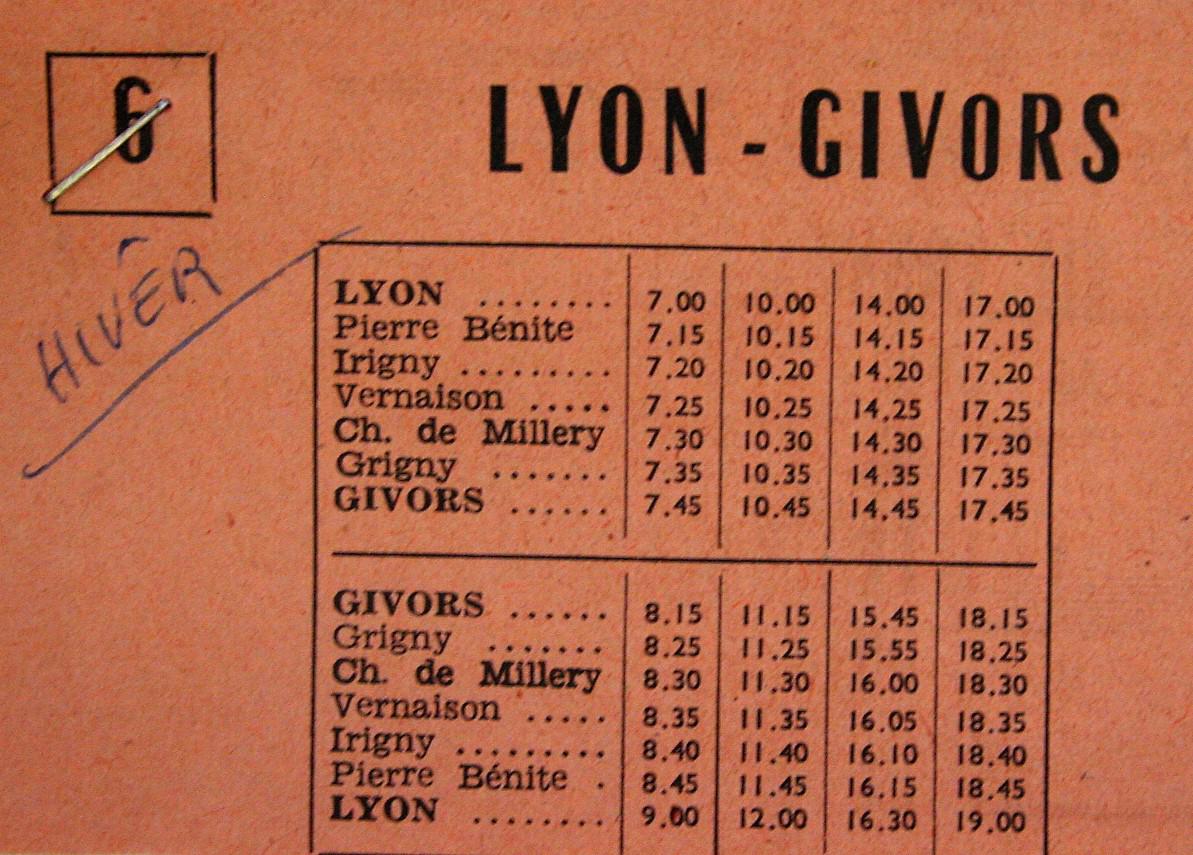
Lyon
Givors in 1950
Clive D’EATH –
27/09/2019
| DORSET
(RURAL) |
DORSET (URBAN) | SOMERSET |
WILTSHIRE |
HAMPSHIRE |
| FAROE ISLANDS | FRANCE (NATIONAL) | FRANCE (REGIONAL) | ISLE
OF SKYE |
LINCOLNSHIRE |